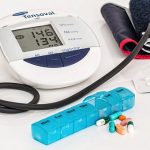Proper diabetes care can reduce the risk of complications. It’s important to pay attention to both physical needs and mental health when managing diabetes. Read on to learn more about specific actions to stay healthy as you manage diabetes.
Check Your Blood Sugar
High blood sugar in diabetes contributes to a host of potential complications, so keeping your blood sugar controlled is essential. Checking blood sugar can be done in different ways, from lab tests drawn at your healthcare provider’s office to checking your blood sugar at home.
Complications of Uncontrolled Diabetes
Controlling diabetes is important, since high blood sugar can lead to the following complications:
- Nerve damage, especially in feet (neuropathy)
- Foot ulcers
- Skin and gum disease
- Diabetic eye disease
- Kidney disease
- Cardiovascular disease like heart attack and stroke
- Sexual dysfunction
Two potentially life-threatening complications of very high blood sugar are diabetic ketoacidosis (DKA) and hyperosmolar hyperglycemic state (HHS). Your healthcare provider can order a blood test called a hemoglobin A1C to get a sense of your level of blood sugar control over the past three months.
Ideally, this number should be less than 7% in people with diabetes, though individualized goals may be recommended by your healthcare provider. Checking blood sugar at home requires a glucose monitor, testing strips, a small needle called a lancet, and alcohol wipes.
After washing and drying your hands, place a fresh testing strip into the glucose monitor. Then clean the skin of a finger pad with an alcohol wipe. Use the lancet to prick your finger, and squeeze your finger to bring out a drop of blood.
Collect the blood on the testing strip. The monitor will report your blood sugar level. Be sure to dispose of the lancet in an appropriate container.
Keep Your Blood Pressure Under Control
Diabetes and high blood pressure often go hand in hand. Having both conditions drastically increases your risk of cardiovascular disease. About 80% of adults with diabetes also have high blood pressure, and blood pressure should be treated to a goal of less than 130/80 mmHg (millimeters of mercury).
Get Exercise
Another important step to controlling blood sugar and managing weight is staying active. Everyone should aim for 150 minutes of physical activity weekly.
Activities to try include:
- Walking at a brisk pace
- Dance classes
- Tennis
- Bicycling
- Swimming
In addition to helping control diabetes, exercise has benefits for heart health, mood, and muscle and bone health.
Try Health Surgeon’s Calories Burned Calculator to discover how many calories you can burn doing over 100 different activities!
Stop Smoking
Smoking has many harmful effects on the body, and it’s especially important for people with diabetes to quit smoking and avoid secondhand smoke.
One of the reasons is that smoke exposure increases your risk of cardiovascular disease, and people with diabetes are already at a higher risk for heart disease and stroke.
In addition, nicotine actually increases blood sugar levels and can lead to type 2 diabetes. Note that when you quit smoking, your blood sugar levels can decrease and your medication requirements may change.
Eat a Diabetes-Friendly Diet
One of the most important ways to keep your diabetes under control is to eat a diabetes-friendly diet. It doesn’t have to be a bland and restrictive diet, but it does mean cutting down on carbs. Things to avoid include:
- Sugar-sweetened foods like pastries, some cereals, and candy
- Sugar-sweetened drinks like juices and sodas
- Refined carbohydrates like white breads, crackers, and pastas
- Highly processed carbohydrates like chips and cereal bars
In a diabetes-friendly diet, there are still lots of delicious options. Choose low-glycemic-index foods. These foods have carbohydrates that are digested more slowly and are high in fiber:
- Whole grains instead of white grains
- Oatmeal instead of cereal
- Vegetables that are low in starch, like leafy greens, broccoli, and zucchini (not potatoes and corn)
- Beans and legumes (but watch out for canned versions that include sugar)
Dietary changes, along with exercise and weight loss when indicated, can help significantly reduce blood sugar. Some people are even able to put type 2 diabetes into remission this way.
Is healthy eating the same as going on a diet?
Healthy eating is not a diet. It means making changes you can live with and enjoy for the rest of your life. Diets are temporary. Because you give up so much when you diet, you may be hungry and think about food all the time. And after you stop dieting, you also may overeat to make up for what you missed.
Eating a healthy, balanced variety of foods is far more satisfying. And if you match that with more physical activity, you are more likely to get to a healthy weight—and stay there—than if you diet.
How do you get started on healthy eating?
Healthy eating starts with learning new ways to eat, such as adding more fresh fruits, vegetables, and whole grains and cutting back on foods that have a lot of fat, salt, and sugar.
A change to healthier eating also includes learning about balance, variety, and moderation.
- Aim for balance. Most days, eat from each food group—grains, protein foods, vegetables and fruits, and dairy. Listen to your body. Eat when you’re hungry. Stop when you feel satisfied.
- Look for variety. Be adventurous. Choose different foods in each food group. For example, don’t reach for an apple every time you choose a fruit. Eating a variety of foods each day will help you get all the nutrients you need.
- Practice moderation. Don’t have too much or too little of one thing. All foods, if eaten in moderation, can be part of healthy eating. Even sweets can be okay.
Why pay attention to what you eat?
Healthy eating will help you get the right balance of vitamins, minerals, and other nutrients. It will help you feel your best and have plenty of energy. It can help you handle stress better.
Healthy eating is one of the best things you can do to prevent and control many health problems, such as:
- Heart disease.
- High blood pressure.
- Type 2 diabetes.
- Some types of cancer.
How do you make healthy eating a habit?
First, think about your reasons for healthier eating. Do you want to improve your health? Do you want to feel better? Are you trying to set an example for your kids?
Next, think about some small changes you can make. Pick ones you can keep doing.
- Don’t try to change everything at once.
- Set an easy goal you can reach, like having a salad and a piece of fruit each day.
- Make a long-term goal too, such as having one vegetarian dinner a week.
Where can you get support?
Having support from others can be a huge help. The more support you have, the easier it will be to make changes. Ask family and friends to practice healthy eating with you. Have them help you make meals, and share healthy, delicious recipes and cooking tips.
Pay Attention to Oral Health
High blood sugar in diabetes can increase your risk of gum disease, tooth decay, and infection. Diabetes results in excess sugar in the saliva, dry mouth, and poor wound healing.
To keep your mouth healthy, follow oral hygiene steps, including:
- Making regular visits to your dentist for preventive care (usually every six months)
- Brushing your teeth twice daily
- Flossing your teeth daily
- Avoiding cigarettes
Schedule Kidney Tests
Diabetes is the top cause of chronic kidney disease. One-third of people with diabetes also have kidney disease. Controlling blood sugar is important to prevent the development and progression of kidney disease in diabetes.
Kidney disease doesn’t cause any symptoms in the early stages. Your healthcare provider will monitor your kidney function with regular blood testing at scheduled visits as part of your diabetes care plan.
Check Your Cholesterol
High cholesterol is another condition that occurs with diabetes, drastically increasing heart disease risk. There is evidence that the cholesterol medication known as statins improve survival, and reduce the risk of cardiovascular disease in those with diabetes.
Care for Your Feet
High blood sugar in diabetes increases the risk of foot ulcers, which can lead to serious infections of the skin, soft tissue, and bones. In severe cases, it may require amputation.
People with diabetes can develop numbness in their feet due to damage of small nerves, which makes their feet susceptible to injury and infection. Socks and well-fitting shoes should be worn to protect the feet, and feet should be kept clean and nails trimmed regularly.
Be sure to examine your feet nightly for any signs of ulcers, injury, or infection. Look for discolored or broken skin, deep cracks, redness, and drainage. Any concerns should be reported to and examined by your diabetes care team or a podiatrist. It’s important to maintain foot health with diabetes by doing the following:
- Wear socks and well-fitted, comfortable shoes that do not rub or cause blisters.
- Trim your toenails regularly.
- Check your feet, or have a loved one check your feet, each night to look for signs of infection, broken skin, or injury.
- Visit a podiatrist at least once yearly for foot exams.
What to Look for on Daily Foot Checks
Since diabetes can damage the nerves in your feet, you may not notice that an injury has occurred or an ulcer is starting. Look closely for the following:
- Discolored skin
- Broken skin
- Blisters
- Deep cracks in the skin, which can be prone to infection
- Redness and swelling around the toenails (paronychia), which can be a sign of infection
- Drainage of liquid or pus
If you have any concerns, let your healthcare provider know.
Have Regular Eye Exams
Another complication of diabetes is eye disease, which can lead to vision problems and even blindness. In the short term, high blood sugar can cause blurred vision, but over time, high blood sugar can cause the following:
- Diabetic retinopathy (blood vessel problems in the back layer of the eye)
- Macular edema (swelling of the part of the eye responsible for high acuity vision)
- Cataracts (clouding of the lens of the eye)
- Glaucoma (increased pressure in the eye that can lead to problems with the optic nerve)
Don’t ignore any eye symptoms like new floaters, flashes of light, or other vision problems. People with diabetes should see an eye care specialist for a dilated eye exam at least once per year.
Stay Positive
A diagnosis of diabetes can bring anxiety about complications, side effects from medications, frustration about controlling blood sugar, and feelings of deprivation around dietary changes.
Depression is common in people with diabetes, which is a treatable condition with medication and talk therapy. Signs of depression include the following:
- Depressed mood (feeling low and experiencing a loss of interest)
- Fatigue
- Sleep disturbance
- Changes in appetite
- Decreased interest in things you used to enjoy
- Difficulty concentrating
- Suicidal ideation (thoughts or ideas)
Take Medication as Prescribed
Medications are a big part of a diabetes care plan, and for many people with diabetes, they are essential for blood sugar control. Diabetes medication may include pills, injectable medications, and insulin.
Your healthcare provider may recommend medications like statins for cholesterol management, aspirin for the prevention of stroke and heart attack, and blood pressure medications.
Taking your medications as prescribed is one of the best ways to keep your blood sugar, cholesterol, and blood pressure under control.
How Often to See Your Healthcare Provider
Depending on how well your diabetes is controlled, you should see your diabetes care provider every three to six months. Those who are working to get their blood sugar under control will need a hemoglobin A1c measured every three months.
Summary
Diabetes can cause a host of complications from head to toe, including depression, eye disease, dental disease, cardiovascular disease, kidney disease, and diabetic foot ulcers. Paramount to diabetes care is controlling blood sugar, but it’s just as important to identify and treat these potential complications.
A comprehensive diabetes care plan includes attention to possible complications, with regular visits with your healthcare provider for screening and medication management.
A diagnosis of diabetes is life-changing. It can be stressful to keep track of your medication and blood sugar monitoring, as well as making lifestyle changes to avoid complications and to improve your condition.
Know that you’re not in this alone. Your healthcare provider can offer information and advice on ways to start achievable lifestyle modifications, including dietary changes, exercise, and smoking cessation.
READ MORE: 24 Natural Home Remedies For Diabetes









